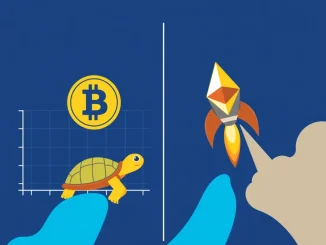
The world of cryptocurrency is never short on bold predictions and strong opinions. Recently, the spotlight turned to Cardano founder Charles Hoskinson, who shared a rather startling outlook on the future of Ethereum, one of the largest players in the Crypto Market.
Charles Hoskinson’s Bold Prediction for Ethereum
During a recent ‘Ask Me Anything’ (AMA) session, Charles Hoskinson, the driving force behind Cardano, didn’t mince words when discussing Ethereum. He put forth a controversial prediction: Ethereum might not stand the test of time, potentially disappearing within the next 10 to 15 years.
To illustrate his point, Hoskinson drew a striking comparison, likening Ethereum’s current position to that of BlackBerry. Remember BlackBerry? Once a dominant force in mobile technology, it ultimately lost its relevance and market share due to its inability to innovate and adapt quickly enough to changing times and competing technologies.
Hoskinson suggests Ethereum faces a similar risk if it doesn’t address fundamental issues he perceives within its architecture and governance.
Why Hoskinson Criticizes Ethereum’s Foundation
Hoskinson’s critique isn’t just a vague feeling; he points to specific technical aspects of the Ethereum network that he believes are fundamentally flawed. His criticisms include:
- Flawed Accounting Model: He suggests the way Ethereum handles its ledger and transactions has inherent weaknesses.
- Virtual Machine Issues: Criticisms are leveled against the Ethereum Virtual Machine (EVM), the engine that executes smart contracts.
- Consensus Mechanism Concerns: While Ethereum transitioned to Proof-of-Stake, Hoskinson implies there are still underlying problems with its approach to achieving consensus.
These technical foundation issues, in Hoskinson’s view, create vulnerabilities and limitations for the network’s long-term viability and scalability.
Are Ethereum Layer-2s ‘Parasitic’?
Adding another layer to his criticism, Hoskinson described Ethereum’s reliance on layer-2 scaling solutions as ‘parasitic’. Layer-2 networks are designed to handle transactions off the main Ethereum chain (Layer-1) to reduce congestion and costs. While widely seen as essential for scaling Ethereum, Hoskinson argues that instead of strengthening the main chain, these Layer-2s ‘drain value’ from it.
This perspective challenges the common narrative that Layer-2s are a net positive, suggesting they might fragment the ecosystem and diminish the core network’s importance or value accrual.
The Governance Gap and User Migration
A significant part of Hoskinson’s argument rests on Ethereum’s governance model. He believes Ethereum lacks a robust, on-chain governance system capable of effectively resolving its complex technical and community issues. Without a clear, decentralized mechanism for decision-making and implementing upgrades, he fears the network will struggle to adapt and improve.
This perceived lack of adaptable governance, combined with the technical flaws and Layer-2 dynamics, leads Hoskinson to predict that users and developers will eventually become frustrated and migrate to other platforms that offer better technology or governance models. Cardano, naturally, is often presented by Hoskinson as one such alternative.
Ethereum’s Current Standing in the Crypto Market
Despite Hoskinson’s dire prediction, Ethereum remains a giant in the Crypto Market. According to CoinMarketCap data, ETH is currently trading at $1,774.25, showing a slight dip of 1.45% over the past 24 hours at the time of the report. It holds the second-largest market capitalization, powering a vast ecosystem of decentralized applications (dApps), NFTs, and DeFi protocols.
The current price and market position highlight the significant network effect and adoption Ethereum has achieved, factors that proponents argue make its predicted demise highly unlikely.
Conclusion: A Future Uncertain?
Charles Hoskinson’s comparison of Ethereum to BlackBerry and his prediction of its potential disappearance within 10-15 years offer a stark and ‘shocking’ perspective on the future of one of the leading blockchain networks. His criticisms focus on what he sees as fundamental technical flaws, the nature of Layer-2 scaling, and a lack of effective on-chain governance.
While Charles Hoskinson and the Cardano community clearly see a different path forward for blockchain technology, Ethereum continues to evolve and maintain a dominant position in the Crypto Market. Whether Ethereum can adapt sufficiently to counter these criticisms and predictions remains a key question for the entire crypto space. Only time will tell if Hoskinson’s warning becomes a reality or if Ethereum proves to be more resilient than the fate of BlackBerry.



